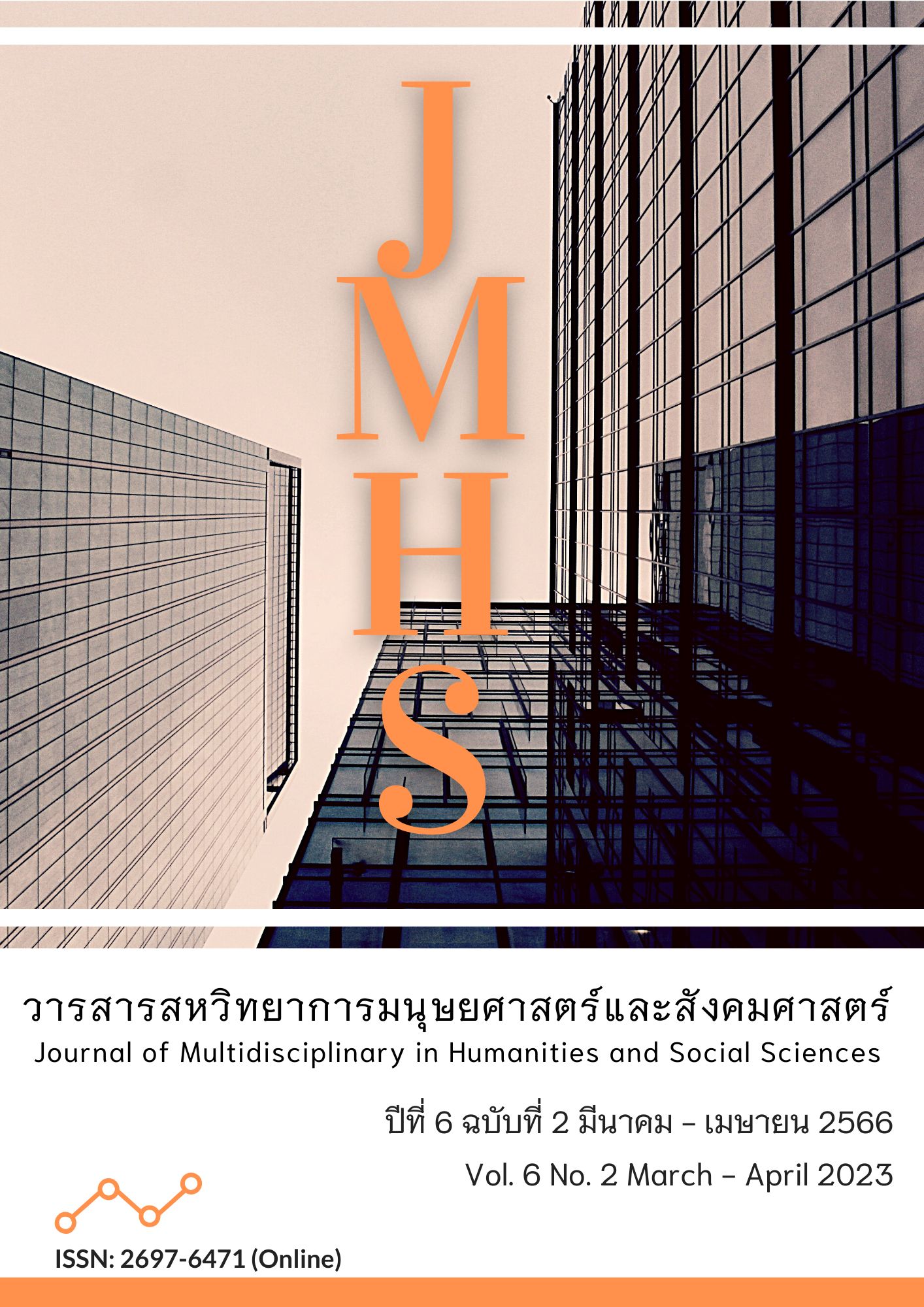The Development of Instructional Geometry Problems Activities to Enhance Critical Problem Solving by Design Thinking Process for Secondary Students
Main Article Content
Abstract
This article aimed (1) to develop instructional geometry problems activities to enhance critical problem solving and (2) to compare the critical problem-solving abilities of students. The research model was experimental research. The population consisted of students who studied geometry-related content at the junior high school level at Roong-Aroon School. The target group consisted of 27 Mathayomsuksa 4 students selected through purposive sampling. The interventions used for this research consisted of (1) the tool for instructional geometry problem-solving activities, which is 8 learning lesson plans divided into 4 group activities and 4 individual activities; and (2) a tool for assessing students' critical problem-solving ability, which is a test to measure the ability before studying, between, and after the posttest. Data were analyzed using E1/E2 efficiency calculations and a t-test for dependent sample statistics. The research results were found as follows: 1. The instructional geometry problems activities to enhance critical problem-solving by design thinking process for secondary students with efficiency were equal to 78.21/75.28, which was higher than the criteria. 2. Students’ critical problem-solving abilities after being taught instructional geometry problems activities by the design thinking process were higher than before being taught at .01 level of significance. The results of this research will be helpful for the professional development of mathematics teachers, research, and the design of instructional activities, including enhancing problem-solving skills, critical thinking, or critical problem solving.
Article Details

This work is licensed under a Creative Commons Attribution-NonCommercial-NoDerivatives 4.0 International License.
Views and opinions appearing in the Journal it is the responsibility of the author of the article, and does not constitute the view and responsibility of the editorial team.
References
กมล นาคสุทธิ และ สมยศ ชิดมงคล . (2560). ผลของการจัดกิจกรรมการเรียนรู้คณิตศาสตร์โดยใช้เทคนิคพรู๊ฟแมปปิงในการเขียนพิสูจน์ทางเรขาคณิต ที่ต่อความสามารถในการแก้ให้เหตุผลทางเรขาคณิตของนักเรียนชั้นมัธยมศึกษาปีที่ 2. วารสารอิเล็กทรอนิกส์ทางการศึกษา, 12(2), 18–31. สืบค้นจาก https://so01.tci-thaijo.org/index.php/OJED/article/view/110532
ขวัญเกื้อ แสงแก้ว. (2565). การพัฒนาสื่อส่งเสริมทักษะการอ่านเพื่อความเข้าใจ คิดวิเคราะห์ ของนักเรียนชั้นมัธยมศึกษาปีที่ 3 สังกัดสำนักงานเขตพื้นที่การศึกษามัธยมศึกษาสมุทรสาคร สมุทรสงคราม. วารสารนวัตกรรมการจัดการศึกษาและการวิจัย, 4(2), 93–106. สืบค้นจาก https://so02.tci-thaijo.org/index.php/jemri/article/view/257766
จิรันธนิน คงจีน และ วารีรัตน์ แก้วอุไร. (2562). การพัฒนารูปแบบการจัดการเรียนรู้วิทยาศาสตร์ตามแนวการเรียนรู้อย่างกระตือรือร้นและการช่วยเสริมศักยภาพ เพื่อส่งเสริมความสามารถในการแก้ปัญหาอย่างมีวิจารณญาณ สำหรับนักเรียนชั้นมัธยมศึกษาตอนปลาย.วารสารศึกษาศาสตร์มหาวิทยาลัยนเรศวร, 21(1), 16–29. สืบค้นจาก https://so06.tci-thaijo.org/index.php/edu journal_nu/article/view/86803
ชมนาด เชื้อสุวรรณทวี. (2561). การเรียนการสอนคณิตศาสตร์. กรุงเทพฯ: คณะศึกษาศาสตร์มหาวิทยาลัยศรีนครินทรวิโรฒ.
ชัยยงค์ พรหมวงศ์. (2556). การทดสอบประสิทธิภาพสื่อหรือชุดการสอน. วารสารศิลปากรศึกษาศาสตร์วิจัย, 5(1), 7-20. สืบค้นจาก https://so05.tci-thaijo.org/index.php/suedu reasearchjournal/article/view/28419
ธวัชชัย โพธิบัวทอง และ จิรศักดิ์ สุรังคพิพรรธน์. (2565). แนวทางการพัฒนาการบริหารวิชาการของโรงเรียนมัธยมศึกษาตามแนวคิดความฉลาดทางดิจิทัล. วารสารนวัตกรรมการจัดการศึกษาและการวิจัย, 4(2), 127–140. สืบค้นจาก https://so02.tci-thaijo.org/index.php/jemri/article/ view/258175
นันทชัย นวลสอาด, สุกัญญา หะยีสาและ, ญานิน กองทิพย์ และ เอนก จันทรจรูญ. (2563). การพัฒนากิจกรรมการเรียนรู้เรขาคณิตโดยการบูรณาการแบบเชื่อมโยงเนื้อหากับสถานการณ์ในชีวิตจริง สำหรับนักเรียนชั้นมัธยมศึกษาปีที่ 2. วารสารครุศาสตร์อุตสาหกรรม, 19(1), 47–55. สืบค้นจาก https://ph01.tci-thaijo.org/index.php/JIE/article/view/225231
วนินทร พูนไพบูลย์พิพัฒน์. (2565). การพัฒนาความรู้ในเนื้อหาผนวกวิธีสอนและเทคโนโลยี สำหรับครูคณิตศาสตร์ที่จัดการเรียนรู้แบบผสมผสานด้วย กระบวนการชุมชนแห่งการเรียนรู้ทางวิชาชีพ. วารสารสหวิทยาการมนุษยศาสตร์และสังคมศาสตร์, 5(4), 1601-1620. สืบค้นจาก https://so04.tci-thaijo.org/index.php/jmhs1_s/article/view/260240
วิเชียร ภคพามงคลชัย และ อรพิณ ศิริสัมพันธ์. (2561). การพัฒนาทักษะการคิดอย่างมีวิจารณญาณด้วยการจัดการเรียนรู้โดยใช้การวิจัยเป็นฐานของนักเรียนชั้นมัธยมศึกษาปีที่ 5. วารสารศิลปากรศึกษาศาสตร์วิจัย, 10(2), 241-254. สืบค้นจากhttps://so05.tci-thaijo.org/index.php/ suedureasearchjournal/article/view/86252
วิทวินทร์ ประทังคติ, พิจิตรา ธงพานิช และ สฤษดิ์ ศรีขาว. (2565). ผลการพัฒนารูปแบบการจัดการเรียนรู้ภาษาอังกฤษเสริมสร้างการอ่าน การเขียนอย่างมีวิจารณญาณและการกำกับตนเองในการเรียนรู้ของนักเรียนชั้นมัธยมศึกษาปีที่ 3. วารสารสหวิทยาการมนุษยศาสตร์และสังคมศาสตร์, 5(4), 1601-1620. สืบค้นจาก https://so04.tci-thaijo.org/index.php/jmhs1_s/ article/view/ 261969
ศรีวรรณ ฉัตรสุริยวงศ์ และ มาเรียม นิลพันธุ์. (2559). กระบวนทัศน์การจัดการเรียนรู้โดยใช้ชุมชนเป็นฐานเพื่อส่งเสริมความสามารถด้านการคิดอย่างมีวิจารณญาณและการแก้ปัญหาเชิงสร้างสรรค์สำหรับนักเรียนระดับประถมศึกษา. วารสารศิลปากรศึกษาศาสตร์วิจัย, 8(1), 183-197. สืบค้นจาก https://so05.tci-thaijo.org/index.php/suedureasearchjournal/article/view/ 34694
สถาบันส่งเสริมการสอนวิทยาศาสตร์และเทคโนโลยี. (2555). ทักษะและกระบวนการทางคณิตศาสตร์. (พิมพ์ครั้งที่ 3). กรุงเทพฯ: 3-คิว มีเดีย.
สถาบันส่งเสริมการสอนวิทยาศาสตร์และเทคโนโลยี กระทรวงศึกษาธิการ. (2560). คู่มือการใช้หลักสูตรกลุ่มสาระการเรียนรู้คณิตศาสตร์ (ฉบับปรับปรุง พ.ศ. 2560) ตามหลักสูตรแกนกลางการศึกษาขั้นพื้นฐาน พ.ศ. 2551. กรุงเทพฯ: สถาบันส่งเสริมการสอนวิทยาศาสตร์และเทคโนโลยี กระทรวงศึกษาธิการ.
อัมพร ม้าคนอง. (2559). ทักษะและกระบวนการทางคณิตศาสตร์ : การพัฒนาเพื่อพัฒนาการ. (พิมพ์ครั้งที่ 3). กรุงเทพฯ: คณะครุศาสตร์, จุฬาลงกรณ์มหาวิทยาลัย.
Graves. M. F., Juel C., & Graves. M. F. (2004). Teaching Reading in the 21st Century. New York: Pearson Education.
Matthee, M., & Turpin, M. (2019). Teaching Critical Thinking, Problem Solving, and Design Thinking: Preparing IS Students for The Future. Journal of Information Systems Education, 30(4), 242-252.
NCTM. (2000). Principles and Standards for School Mathematics. Virginia: National Council of Teacher of Mathematics.
Paul, R. (1992). Critical Thinking: What, Why, and How. New Directions for Community Colleges, 77, 3-24.
Polya, G. (1957). How To Solve It: A New Aspect of Mathematical Method. New York: Doubleday & Company.
Singapore Curriculum. (2020). Mathematics Syllabuses Secondary One to Four Express Course Normal (Academic) Course. Singapore: Ministry of Education.
The d.school. (2010). Bootcamp bootleg (Thai translation ฉบับภาษาไทย). The d.school. Retrieved November 10, 2021, from https://iohhmblog.files.wordpress.com/2017/10/d-school-bootcamp-bootleg-thai.pdf


